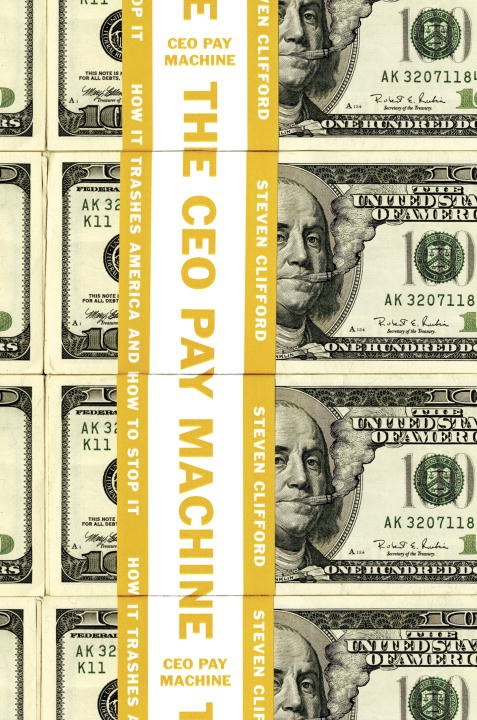The CEO Pay Machine
May 10, 2017
Steven Clifford's new book on CEO compensation "demolishes the prevailing business orthodoxy that has led to its enormous and immensely damaging rise."

Former top CEO Steven Clifford demolishes the prevailing business orthodoxy that has led to an enormous and immensely damaging rise in CEO compensation inThe CEO Pay Machine: How It Trashes America and How to Stop It (Blue Rider Press, May 8, 2017). From 1978 to 2014, the average large company CEO’s pay rose tenfold (adjusted for inflation), to an average of $13.5 million to $30-plus million (depending on the calculation method used). Over the same period, the average worker’s wages grew from $48,000 (adjusted for inflation) to just $53,200—an increase of less than half of 1% per year. To put it another way, CEO pay has grown 90 times faster than the pay of a typical worker since 1978. [p. 21]
The consequences have been severe, for everything from income inequality to employee morale, overall economic growth, and democracy itself. In addition, Clifford says, the CEO Pay Machine is not merely a symptom of increasing income inequality, but a root cause of it. The top 0.1% received 40% of all economic gains since 1980, while the 99% got shafted. Furthermore, two-thirds of the 0.1% are business executives. Contrary to popular belief, other highly paid people like top actors, athletes, and entertainers make up only a small portion of this upper echelon.
What’s more, and perhaps even more surprising, is that exorbitant CEO pay has been terrible for companies and their shareholders. In fact, objective analysis shows that the huge cash bonuses and stock options granted to CEOs with the aim of increasing shareholder value (not to mention extraordinary perks and benefits) are actually counterproductive, leading to more selfish CEO behavior and lower rather than higher returns to shareholders.
The CEO Pay Machine—What it Is and How it Works
Why then, despite periodic bursts of public outrage, attacks from politicians like Bernie Sanders, and critiques from authors like Thomas Piketty, has CEO pay continued to escalate—often to the nine-figure level—with no slowdown in sight? The answer, Clifford says, is what he calls the CEO Pay Machine—the interlocking CEO pay procedures and practices that may have once seemed reasonable, but have collectively ensured a dizzying upward spiral in CEO compensation. As Clifford shows with clarity and wit, using plentiful real-world examples, the Machine has mechanically and inexorably made CEO pay escalation a mathematical certainty. Furthermore—by using absurd peer group comparisons, inappropriate benchmarking, and ridiculously elastic bonus ranges—this system assures that all CEOs will be paid above average and will endlessly play compensation leapfrog with other CEOs.
A lot of angry people, Clifford observes, think the explosion in CEO pay is a consequence of globalization and greed. But other advanced economies function well without bestowing vast wealth on CEOs. In the United States today, the ration of CEO-to-average-worker pay is somewhere between 300 and 700 to 1, depending on the method of calculation. In Japan, it is 16 to 1, in Denmark it is 48 to 1, and in the UK it is 84 to 1. Why is the United States such an outlier? Can American CEOs really be 20 to 60 times better (or greedier) than Japanese CEOs?
Moreover, Clifford contends, the CEO pay explosion is more complex than most people understand. In order to curtail it, corporate boards, government regulators, shareholders, politicians, and editorial writers need to understand how the CEO Pay Machine actually works—how its parts interact, and how every step in the process pushes CEO pay to higher and higher levels. Clifford—a Harvard MBA who served as a CEO for fourteen years, has been a director of thirteen companies, and has chaired many compensation committees that actually determine CEO pay—has seen how the CEO Pay Machine works from the inside like few others have. As he wryly notes, “I now bite the hand that fed me for many years.” [p. 25]
Lessons from the Highest Paid CEOs
When Clifford started writing his book in 2013, he learned that Stephen J. Hemsley of UnitedHealth Group, who made $102 million, and John Hammergren of McKesson, who made $145 million, were named the highest paid American CEOs in 2011 and 2012. The highest paid CEOs of 2013 and 2014 were Charif Souki of Cheniere Energy, who made $142 million, and David Zaslav of Discovery Communications, who made $156 million or $224 million, depending on how you count. As Clifford notes, these men are essentially high-level corporate functionaries with capabilities similar to thousands of others, essentially unknown outside of business circles, with not a single visionary technology entrepreneur, business pioneer, or iconic captain of industry among them.
“Each of these CEOs,” Clifford writes, “demonstrated a different way to be preposterously overpaid—Hemsley and Hammergren by cashing in options previously awarded, Souki through multiple awards of restricted stock, and Zaslav with a large signing bonus plus option gains. However, the small details, such as how the board set easy bogeys [bonus targets], cavalierly granted equity, and changed the numbers after the fact, are more revealing than the astounding pay amounts. Incredibly, none of these four companies produced exceptional financial results in the year in question. In fact, three of the four had bad years financially. What is remarkable is not how much these four CEOs achieved, but how little they achieved relative to their compensation.” [pp. 130-1]
The Five Delusions of the CEO Pay Machine—And Why They’re All Demonstrably False
But if the CEO Pay Machine is so destructive, Clifford asks, then why do companies continue to use it? In short, because everybody else does it. Because the really smart guys who sit on the big corporate boards do it this way—and they must know what they’re doing. Because the supposed experts—the outside pay consultants whose huge fees depend on keeping the Machine going—prescribe it. But the reality, Clifford says, is that the CEO Pay Machine is based on five demonstrably false delusions:
- The importance delusion: The CEO is responsible for the performance of the company. If the company does well, he (and they’re almost all he) should get most of the credit and the rewards. In actuality, aside from visionary founders such as Bill Gates, Jeff Bezos, and Mark Zuckerman, there is scant difference between competing internal candidates for CEO, and three quarters of CEO positions are filled internally.
- The market delusion: There’s a competitive market for CEOs that is driven by supply and demand. High prices reflect the low supply of good CEOs and the large number of companies that want to hire them. There is no market for CEOs because their skills are highly specific to particular companies and industries. CEOs rarely jump ship and when they do, they usually fail.
- The motivation delusion: Bonuses are the best way to motivate CEOs to do their job. Counter-intuitively, financial incentives actually reduce motivation.
- The performance delusion: Corporate boards can effectively measure and reward CEO performance. Business is simply too complex and random for boards and their advisors to design a system that accurately measures and appropriately rewards CEO performance. Specific pay-for-performance measures merely introduce perverse incentives, unintended consequences, and higher CEO pay.
- The alignment delusion. Stock options and measurable bonus goals align the interests of the CEOs and shareholders. CEO bonuses actually make CEOs more selfish and less aligned with the interest of the shareholders.
“I find it congruous,” Clifford writes, “that modern business corporations pride themselves on rigorous quantifying, analyzing, and testing and then choose to pay their CEOs hundreds of millions based upon beliefs that are demonstrably false and pay systems that are rigged. But directors hold these five fallacies to be axiomatic. If they were subjected to empirical validation or questioning, the CEO Pay Machine would implode, and directors would have to start from scratch.” [p. 188]
How to Stop the CEO Pay Machine
The solution Clifford proposes is an eminently practical and achievable one, based on his intimate knowledge of the issue from every angle. The central feature of his plan is a luxury tax on executive pay over $6 million in a year, which would quickly induce most companies to sharply curb CEO pay. Over time, this reform could increase the average American’s income by 20%. Clifford also proposes that CEOs should receive only a salary and restricted stock, rather than the pay-for-performance bonuses and loosely restricted stock options that make up the bulk of current CEO compensation packages. Indeed, he argues, CEO compensation could decrease by 90% with no negative impact on company performance.
Passionate, provocative, and eye-opening, The CEO Pay Machine offers a clear and informed explanation of one of the most controversial economic and ethical issues of our time, which is sure to prompt renewed debate about a topic currently at the forefront of the national conversation.
ABOUT THE AUTHOR
Steven Clifford served as CEO for King Broadcasting Company for five years and National Mobile Television for nine years. His previous jobs included Chief Financial Officer for King Broadcasting Company and Vice President for Bankers Trust Company. He has been a director of thirteen public and private companies. As Special Deputy Comptroller for the City of New York in the 1970s, Clifford played a key role in helping the city avoid bankruptcy. He holds a BA from Columbia University and an MBA with Distinction from Harvard Business School. He served in the United States Army Reserves for six years. He and his wife of forty-six years, Judith, have lived in Seattle since 1978. They have two daughters and four grandchildren. Since 2010 he has written a humor blog for The Huffington Post.


